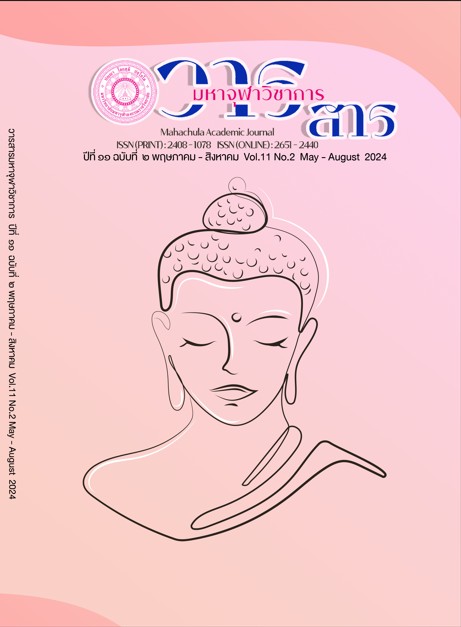Influence of Personal Factors, Self-Efficacy, and Social Support toward Self-Determination of Undergraduate Music Performance Students in Bangkok Metropolitan Region
Main Article Content
Abstract
These objectives of the research were (1) the differences in self-determination among undergraduate music performance students based on personal factors, such as age, academic year, and instrument type (2) the relationships between self-efficacy and social support with self-determination among undergraduate music performance students and (3) the influence of personal factors, self-efficacy, and social support on students' self-determination. The research employed a quantitative research design with a sample of 562 undergraduate music performance students from various music institutions in Bangkok Metropolitan Region. Data were collected using questionnaires, and statistical analysis included percentage, mean, standard deviation, one-way ANOVA, Pearson's correlation coefficient, and stepwise multiple regression analysis.
The findings of the research revealed the following: (1) There were significant differences in self-determination among music students with varying ages, academic years, and instrument types. (2) Self-efficacy and social support had significant positive relationships with self-determination among music students at a statistically significant level of .01. (3) Self-efficacy, social support, and academic years collectively predicted 69.10% of the variance in students' self-determination.
Article Details

This work is licensed under a Creative Commons Attribution-NonCommercial-NoDerivatives 4.0 International License.
References
Altenmuller, Eckart and Christos I Ioannou. Performance Psychology. San Diego : Academic Press, 2016.
Bandura, Albert. "The Explanatory and Predictive Scope of Self-Efficacy Theory". Journal of social and clinical psychology. vol. 4 no. 3, (September 1986) : 359-373.
______. Self-Efficacy: The Exercise of Control. W H Freeman/Times Books/ Henry Holt & Co, 1997.
Biasutti, Michele. "Pedagogical Applications of Cognitive Research on Musical Improvisation". Frontiers in psychology. vol. 6 (May 2015) : 614.
Blackwell, Lisa S et al. "Implicit Theories of Intelligence Predict Achievement across an Adolescent Transition: A Longitudinal Study and an Intervention". Child development. vol. 78, no. 1, (February 2007) : 246-263.
Fletcher, Phillip D et al. "Music, Reward and Frontotemporal Dementia". Brain. vol. 137, no. 10, (October 2014) : e300.
House, James S et al. "Structures and Processes of Social Support". Annual review of sociology. vol. 14 No. 1 (November 1988): 293-318.
Kassis, Wassilis et al. "The Role of Received Social Support and Self-Efficacy for the Satisfaction of Basic Psychological Needs in Teacher Education". European Journal of Teacher Education. vol. 42 No. 3 (February 2019) : 391-409.
McPherson, Gary E, Jane W Davidson, and Paul Evans. The Child as Musician: A Handbook of Musical Developmen. Oxford University Press, 2006.
Rickard, Nikki S, Caroline J Bambrick, and Anneliese Gill. "Absence of Widespread Psychosocial and Cognitive Effects of School-Based Music Instruction in 10–13-Year-Old Students”, International Journal of Music Education, vol. 30 No. 1 (February 2012) : 57-78.
Ryan, Richard M, and Edward L Deci. "Intrinsic and Extrinsic Motivations: Classic Definitions and New Directions”, Contemporary educational psychology, vol. 25 No. 1 (January 2000) : 54-67.
Vansteenkiste, Maarten et al. "Motivational Profiles from a Self-Determination Perspective: The Quality of Motivation Matters". Journal of educational psychology. vol. 101 No. 3 (August 2009) : 671.
Yamane, Taro. Statistics: An Introductory Analysis. 3rd. New York, 1973.
Zelenak, Michael S. "Developing Self-Efficacy to Improve Music Achievement”, Music Educators Journal, vol. 107 No. 2 (December 2020) : 42-50.
กองบริหารการศึกษา สำนักงานอธิการบดี มหาวิทยาลัยมหิดล. (๒๕๖๕). จำนวนนักศึกษามหาวิทยาลัยมหิดล ปีการศึกษา ๒๕๖๔. [ออนไลน์]. แหล่งที่มา : https://op.mahidol
.ac.th/ea/wp-content/uploads/2021/10/Learner2564.xlsx [๑ กุมภาพันธ์ ๒๕๖๖].
กองบริหารงานนักศึกษา มหาวิทยาลัยศิลปากร. (๒๕๖๕). สถิตินักศึกษาจำแนกสภาพตามปีที่รับ. [ออนไลน์]. แหล่งที่มา : http://reg1.su.ac.th/registrar/stat_studententry.asp [๑ กุมภาพันธ์ ๒๕๖๖].
งานทะเบียนคณะศิลปกรรมศาสตร์ จุฬาลงกรณ์มหาวิทยาลัย. (๒๕๖๕). จำนวนนิสิต สาขาวิชา
ดุริยางคศิลป์ ภาคการศึกษาต้น ปีการศึกษา ๒๕๖๕. [ออนไลน์]. แหล่งที่มา : https://drive.google.com/file/d/1V4SKujrCI0iMq9rGqeHZzCP6e8QfNLHb/view?usp=sharing [๑ กุมภาพันธ์ ๒๕๖๖].
ฝ่ายวิชาการและพัฒนาคุณภาพ คณะศิลปกรรมศาสตร์ มหาวิทยาลัยศรีนคริทรวิโรฒ. (๒๕๖๕).
สถิติที่เกี่ยวข้อง. [ออนไลน์]. แหล่งที่มา : http://fofa.swu.ac.th/academic/สถิติที่เกี่ยวข้อง [๑ กุมภาพันธ์ ๒๕๖๖].
มหาวิทยาลัยเกษตรศาสตร์. (๒๕๖๕). จำนวนนิสิตของมหาวิทยาลัยเกษตรศาสตร์ ปีการศึกษา ๒๕๖๔.[ออนไลน์]. แหล่งที่มา : https://www.ku.ac.th/th/statistical-data/view/ข้อมูลนิสิต
[๑ กุมภาพันธ์ ๒๕๖๖].
สถาบันดนตรีกัลยาณิวัฒนา. (๒๕๖๕). รายงานประจำปีงบประมาณ ๒๕๖๔. [ออนไลน์]. แหล่งที่มา : https://www.pgvim.ac.th/th/ [๑ กุมภาพันธ์ ๒๕๖๖].
สำนักงานทะเบียนมหาวิทยาลัยรังสิต. (๒๕๖๕). อัตราคงอยู่ของนักศึกษา. [ออนไลน์]. แหล่งที่มา : http://registrar.rsu.ac.th/Fixed/ [๑ กุมภาพันธ์ ๒๕๖๖].
สำนักส่งเสริมวิชาการและงานทะเบียน มหาวิทยาลัยราชภัฏจันทรเกษม. (๒๕๖๕). ระบบบริการการศึกษา. [ออนไลน์]. แหล่งที่มา : https://reg.chandra.ac.th/registrar/student
set.asp?facultyid=3andacadyear=2565andsemester=1 [๑ กุมภาพันธ์ ๒๕๖๖].
สำนักส่งเสริมวิชาการและงานทะเบียน มหาวิทยาลัยราชภัฏบ้านสมเด็จเจ้าพระยา. (๒๕๖๕). ข้อมูลสถิตินักศึกษาคงอยู่ ภาคปกติ ปีรับเข้า ๒๕๕๗ – ๒๕๕๔ (๔ ปี) และ ๒๕๖๐ – ๒๕๖๔ (๕ ปี) วิทยาลัยการดนตรี มหาวิทยาลัยราชภัฏบ้านสมเด็จเจ้าพระยา. [ออนไลน์]. แหล่งที่มา : https://aar.bsru.ac.th/images/statistic/current/current_student/2564/
music.pdf [๑ กุมภาพันธ์ ๒๕๖๖].


